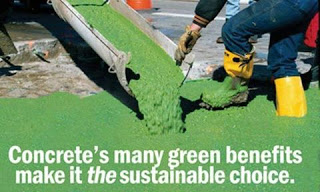Green Concrete, All the facts you should know
Geopolymer concrete, or green concrete, is part of a movement to create construction materials that have a reduced impact on the environment. It is made from a combination of an inorganic polymer and 25 to 100 percent industrial waste. Here is a list of 4 benefits to using green concrete for your next project.
1. Lasts Longer: Green concrete gains strength faster and has a lower rate of shrinkage than concrete made only from Portland Cement. Structures built using green concrete have a better chance of surviving a fire (it can withstand temperatures of up to 2400 degrees on the Fahrenheit scale). It also has a greater resistance to corrosion which is important with the effect pollution has had on the environment (acid rain greatly reduces the longevity of traditional building materials). All of those factors add up to a building that will last much longer than one made with ordinary concrete. Similar concrete mixtures have been found in ancient Roman structures and this material was also used in the Ukraine in the 1950s and 1960s. Over 40 years later those Ukrainian buildings are still standing. If buildings aren\’t constantly having to be rebuilt, fewer construction materials are needed and the impact to the environment during the process of making those materials is reduced.
2. Uses Industrial Waste: Instead of a 100 percent Portland cement mixture, green concrete uses anywhere from 25 to 100 percent fly ash. Fly ash is a byproduct of coal combustion and is gathered from the chimneys of industrial plants (such as power plants) that use coal as a power source. There are copious amounts of this industrial waste product. Hundreds of thousands of acres of land are used to dispose of fly ash. A large increase in the use of green concrete in construction will provide a way to use up fly ash and hopefully free many acres of land.
3. Reduces Energy Consumption: If you use less Portland cement and more fly ash when mixing concrete, then you will use less energy. The materials that are used in Portland cement require huge amounts of coal or natural gas to heat it up to the appropriate temperature to turn them into Portland cement. Fly ash already exists as a byproduct of another industrial process so you are not expending much more energy to use it to create green concrete.
Another way that green concrete reduces energy consumption is that a building constructed from it is more resistant to temperature changes. An architect can use this and design a green concrete building to use energy for heating and cooling more efficiently.
4. Reduces CO2 Emissions: In order to make Portland cement–one of the main ingredients in ordinary cement–pulverized limestone, clay, and sand are heated to 1450 degrees C using natural gas or coal as a fuel. This process is responsible for 5 to 8 percent of all carbon dioxide (CO2) emissions worldwide. The manufacturing of green concrete releases has up to 80 percent fewer CO2 emissions. As a part of a global effort to reduce emissions, switching over completely to using green concrete for construction will help considerably.


















